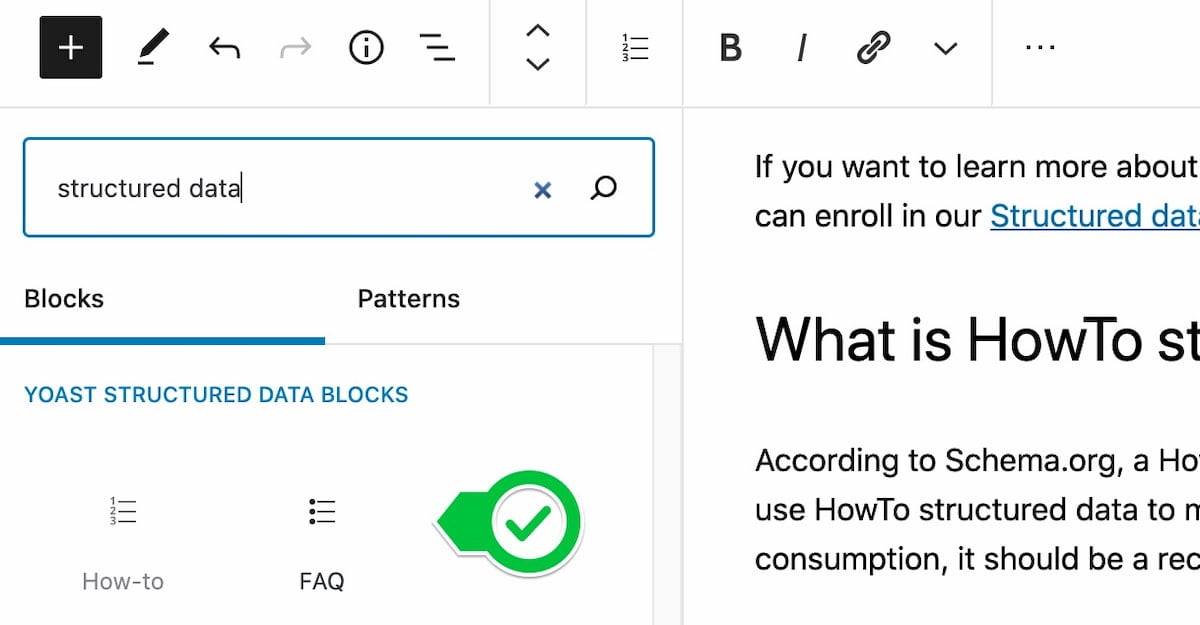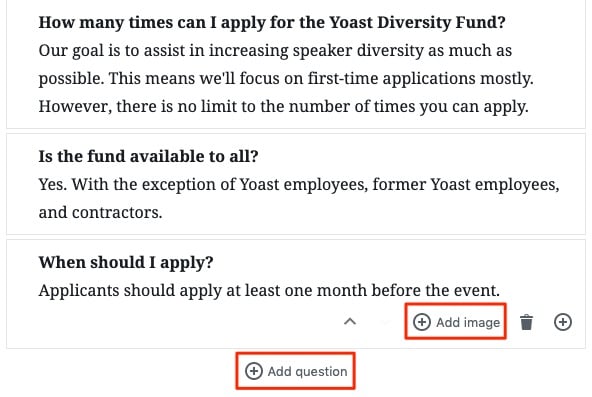Many, many sites have an FAQ page. This is a page where a lot of frequently asked questions get the appropriate answer. It is often a single page filled to the brim with questions and answers. While it’s easy to add one, it’s good to keep in mind that not all sites need an FAQ. Most of the time all you need is good content targeted at the users’ needs. Here, I’ll discuss the use of FAQ pages and show you how to make one yourself with Yoast SEOs free FAQ structured data content block for the WordPress block editor. You won’t believe how easy it is.
For more information on the Yoast SEO Schema structured data implementation, please read our Schema documentation.
What is an FAQ?
FAQ stands for frequently asked questions. It is often a single page collecting a series of questions and their answers on a specific subject, product or company. An FAQ is often seen as a tool to reduce the workload of the customer support team. It is also used to show that you are aware of the issues a customer might have and to provide an answer to that.
Do you really need an FAQ?
Usually, if you need to answer a lot of questions from users in an FAQ, that means that your content is not providing these answers and that you should work on that. Or maybe it is your product or service itself that’s not clear enough? One of the main criticisms of FAQs is that they hardly ever answer the questions consumers really have. They are also lazy: instead of figuring out how to truly answer a question with formidable content — using content design, for instance — people rather throw some random stuff on a page and call it an FAQ.
That’s not to say you should never use an FAQ. Numerous sites successfully apply them — even we use them sparingly. In some cases, they do provide value. Users understand how an FAQ works and are quick to find what they are looking for — if the makers of the page know what they are doing. So don’t make endless lists of loosely related ‘How can I…’ or ‘How to…’ questions, because people will struggle to filter out what they need.
Answer real questions by real users
It has to be a page that’s easy to digest and has to have real answers to real questions by users. You can find scores of these if you search for them: ask your support team for instance! Collect and analyze the issues that come up frequently to see if you’re not missing some pain points in your products or if your content is targeting the wrong questions.
So don’t hide answers to pressings questions away on an FAQ page if you want to answer these in-depth: make an article out of it. This is what SEO deals with: provide an answer that matches your content to the search intent.
Questions and answers spoken out loud?
Google is trying to match a question from a searcher to an answer from a source. If you mark up your questions and answers with FAQ structured data, you tell search engines that this little sentence is a question and that this paragraph is its answer. And all these questions and answers are related to the main topic of the page.
Paragraph-based content is all the rage. One of the reasons? The advent of voice search. Google is looking for easy to understand, block-based content that it can use to answer searchers questions right in the search engine — or by speaking it out loud. Using the Schema property speakable might even speed up this content discovery by determining which part of the content is fit for text-to-speech conversion. Find out more about what’s powering conversational search.
How to build an FAQ page in WordPress via Yoast SEO content blocks
The best way to set up a findable, readable and understandable FAQ page on a WordPress site is by using the Schema structured data content blocks in Yoast SEO. These blocks for the new block editor – formerly known as Gutenberg – make building an FAQ page a piece of cake.
All
the generated structured data for the FAQ will be added to the graph
Yoast SEO generates for every page. This makes it even easier for search
engines to understand your content. Yoast SEO automatically adds the
necessary structured data so search engines like Google can do cool
stuff with it. But, if nothing else, it might even give you an edge over
your competitor. So, let’s get to it!
- Open WordPress’ new block editor
Make a page in WordPress, add a title and an introductory paragraph. Now add the FAQ structured data content block. You can find the Yoast SEO structured data content blocks inside the Add Block modal. Scroll all the way down to find them or type ‘FAQ’ or ‘structured data’ in the search bar, which I’ve highlighted in the screenshot below.

- Add questions and answers
After you’ve added the FAQ block, you can start to add questions and answers to it. Keep in mind that these questions live inside the FAQ block. It’s advisable to keep the content related to each other so you can keep the page clean and focused. So no throwing in random questions.

- Keep filling, check and publish
After adding the first question and answering it well, keep adding the rest of your questions and answers until you’ve filled your FAQ page. In the screenshot below you see some questions filled in. I’ve highlighted two buttons, the Add Image button and the Add Question. These speak for themselves.
Once you are done, you’ll have a well-structured FAQ page with valid structured data. Go to the front-end of your site and check if everything is in order. If not, make the necessary changes.
No comments:
Post a Comment